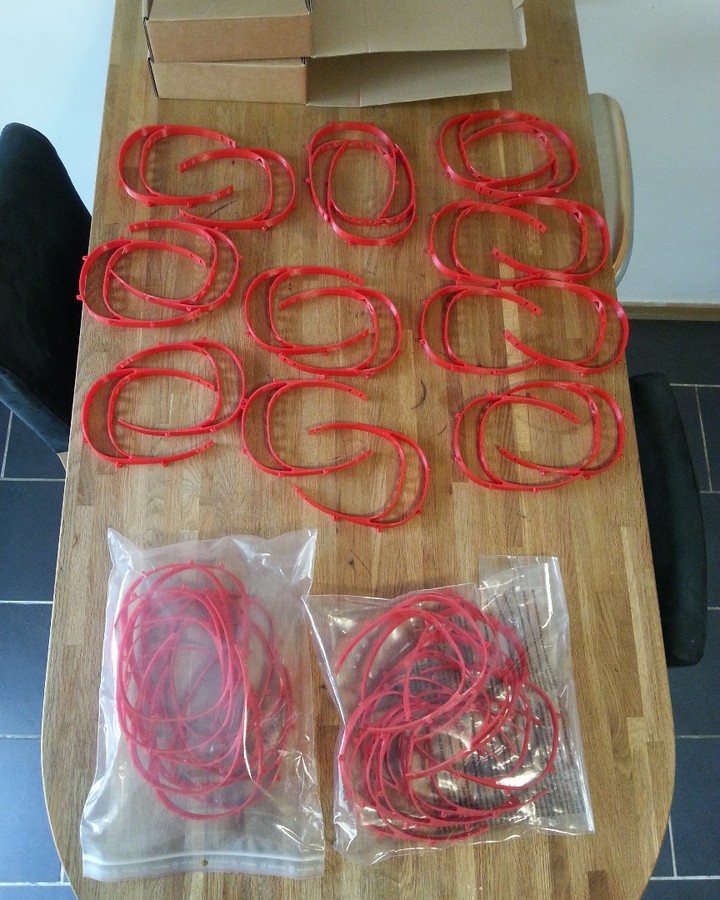Hi guys !
First, I hope you are fine and your family too.
I dropped a few 3d printed parts to volunteers assembling face shields for people fighting the coronavirus.
I am pretty amazed how fast the 3d printing community reacted and how big it is becoming.

How to print "quickly and reliably" ?
I put quickly in bracket, because of the speed and the throughput. Yes for the throughput, speed matters but at what risk: reliability of the print and reliability of the machine. Quality must be good also, I do not only mean only aestethic but strong parts. In this context, we are dealing with technical parts.Safe Slicer settings:
- Larger Extrusion Width (Nozzle: 0.4mm -> 0.5mm, 0.6mm -> 0.72mm, 0.8mm -> 1mm): the geometry of the tip of your nozzle and the geometry of the part to print is the limiting factor.
- Larger Layer Height but not overdo it ( Nozzle: 0.4mm -> 0.28 to 0.32mm, 0.6mm -> 0.4mm): some tuning is needed, the part can become too weak (see cooling/temperature parameters)
- Tune number of perimeters/insets: given the geometry and the extrusion width you can manage to reduce the number of passes made and reduce/avoid the slow shaking movement of the top/bottom or the gap filling (overlap setting is your friend)
- Use Concentric infill for Top/Bottom layers : linear infill or zigzag infill will just take more time
- Cooling parameters: No fan on PETG print for instance, try to reduce it, it makes stronger parts and you can print faster. Set the print time per layer down to 5 or less seconds.
- Keep the same print speed all around: if there is a bit of ringing it does not really matter for functional parts, always start with the print speed you are used to.
- Keep a safe margin on the extrusion throughput , go to max 75% to 80% of the theoretical limit.
- PTFE Short Block: 10 mm^3/sec
- Full Metal Short Block: 15 mm^3/sec
- Volcano Block: 30 mm^3/sec
- Super Volcano Block: 80 mm^3/sec
- Print with higher temperature but do not overdo it , retraction can become ineffective after a threshold and other issues can come around
Extrusion Throughput Calculator
- Extrusion Width (mm):
- Extrusion Flow (%):
- Print Speed (mm/s):
- Layer Height (mm):
- Extrusion Throughput (mm^3/s): {{throughput}}
Example printing a single part on PETG at 230C on an Ender 3
- Standard Print Speed 40mm/sec, Retraction speed 25mm/s with 6mm
- Layer Height 0.2mm with 0.4mm extrusion width, base line 2h22m
- Same speed with larger extrusion width + cooling settings + concentric top/bottom infill: 0.4mm to 0.5mm with 0.2mm layer height: 1h52m (-20% on time)
- Same speed with larger layer height (0.5mm extrusion width instead of 0.4mm):
- 0.24mm layer height 1h33m (-33% on time)
- 0.28mm 1h22m part good (-42% on time)
- 0.32mm 1h12m part correct (-49% on time), extrusion flow about 6.4 mm^3/s
-
Increasing speed from 40mm/sec to 50mm/sec
- 0.32mm 1h05m (part too weak, start to have under extrusion after short retractions sequences)
- 0.28mm 1h12m part correct (-49% on time), extrusion flow about 7 mm^3/s
What about reliability ?
2 minor failures only caused by me ^^
Same quality of the prints over and over, print start and you go.
As you can see I did not increase the print speed and the move speed:
- only a major change on the extrusion flow
- a slight reduction in the number of moves performed by the printer due to the increased layer height, extrusion layer width
- few tweaks here and there to keep the same print speed
- reduce the number of small moves made by the printer using the concentric infill for top/bottom
Happy 3D Printing !
If you want to go further, faster and deeper:
- First priority: Larger nozzle but geometry constraints on the model, and extrusion throughput limitations...
- 0.6mm extrusion width, 40 mm/s, 0.4mm layer height will max out a PTFE Short Block (10 mm^3/s)
- 0.8mm extrusion width, 40 mm/s, 0.5mm layer height will max out a Full Metal Short Block (16 mm^3/s)
- 1.2mm extrusion width, 40 mm/s, 0.6mm layer height will max out a Volcano Block (28.8 mm^3/s)
- Second limitation: Longer heat zone: Volcano, Super Volcano and even bigger (prevent overheating and damage the material)
- Third issue: Extruder Torque, Bite and Speed
- Tuning Speed, Acceleration, Jerk, Junction Deviation
- Tuning Linear Advance Parameters and Retraction settings
- Modification of the part to print faster